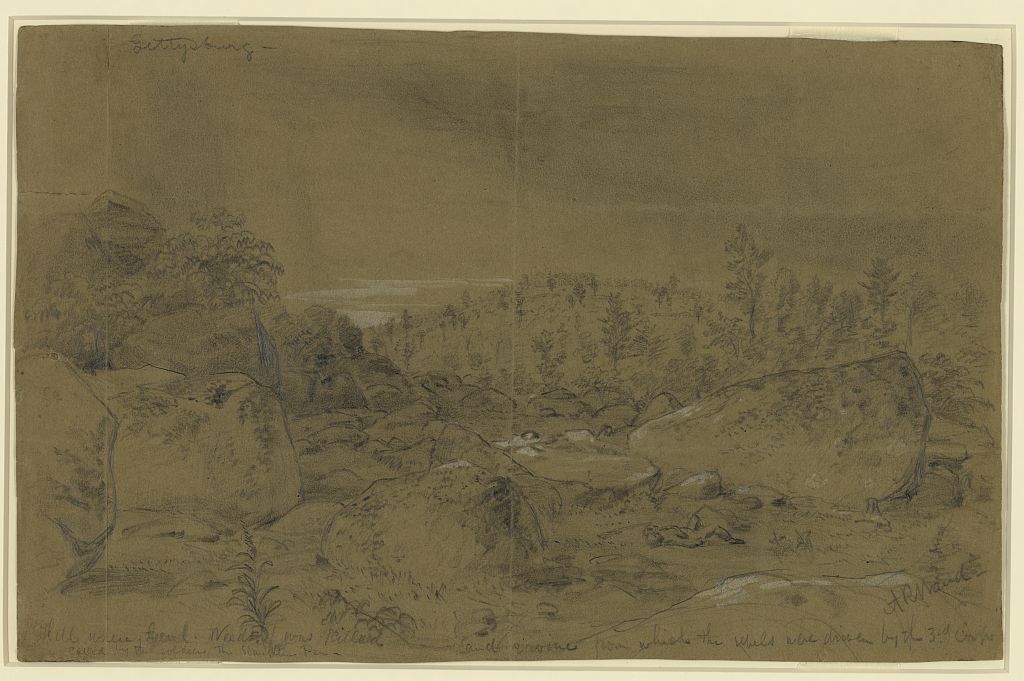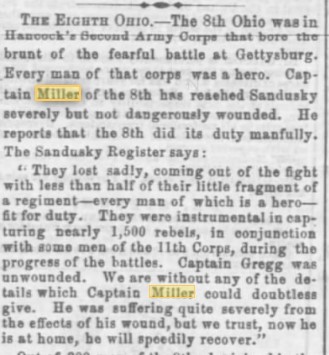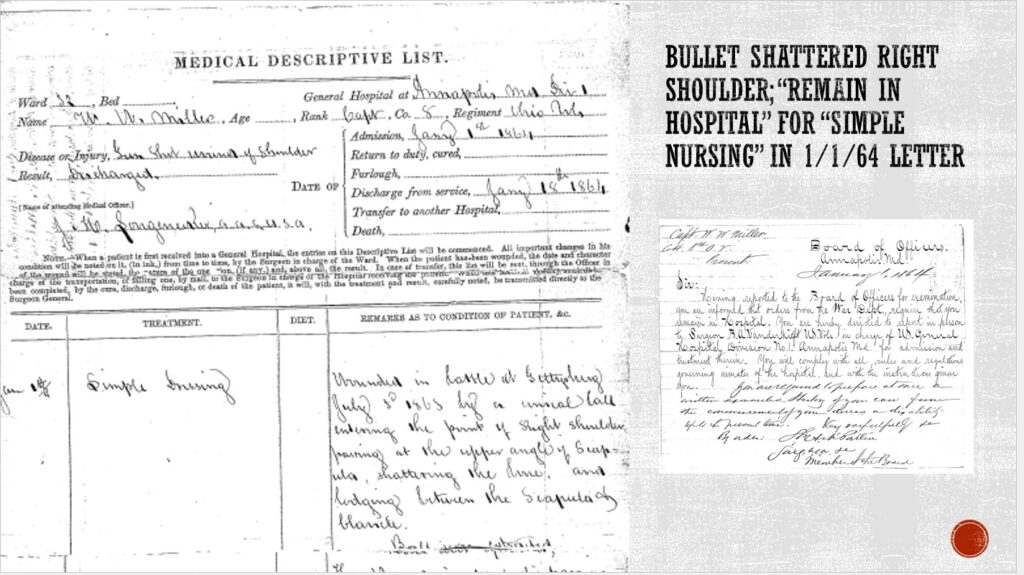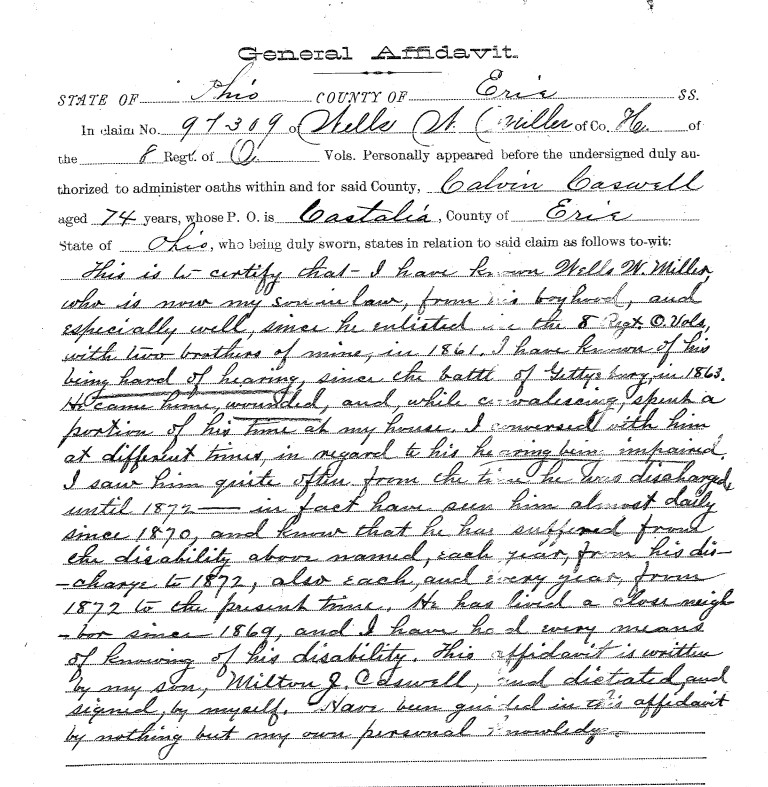
No known restrictions on publication
Miller Family Mystery
After Wells Waite Miller was seriously wounded on July 3, 1863 at Gettysburg, Pennsylvania, there were initially big gaps in my research between that date and 1894 when he became the Secretary of Ohio’s Department of Agriculture. What was he doing, exactly?
I’ve slowly filled in those gaps over the past couple of years, but something continued to puzzle me. Why did documentation for his two children (Corinne and Amos Calvin) say they were born in Marshalltown, Iowa? (Yes, I get that they say this because they were born there. I mean, why?) For a while, I thought that Wells and his wife Mary raised two war orphans who had been born in Iowa, but I couldn’t find confirmation of that, and now I’m not so sure that this theory was correct. Hang tight as I unfold what I’ve learned. I’ll set the stage in this post and then write a part two.
First Year, Post-Gettysburg
Here’s the first mention I’ve found of Wells after his horrific wounds. A July 11, 1863 report from the Cleveland Daily Leader noted, “We are without any of the details which Captain Miller could doubtless give. He was suffering quite severely from the effects of his wound, but we trust, now he is at home, he will speedily recover.”

On January 1, 1864, he was sent to General Hospital in Annapolis, Maryland—the town where he’d been a prisoner of war for about six months from November 1862-May 1863—for an exam. That medical report stated that he should “remain in hospital” for “simple nursing.”

Once I got copies of his pension records, I learned that he convalesced at the home of his future father-in-law, Calvin Caswell.

In March 1864, he applied to serve in the Invalid Corps. The Invalid Corps was created by the War Department for men who’d become permanently disabled by wounds (or disease) in the line of duty. When possible, it made sense to use them in “valuable capacities, such as in garrison, as military police, or on clerk duty. This freed as many able-bodied soldiers as possible for frontline service.”
Fortunately, some happiness also awaited him.
Love is in the Air
On July 4, 1864, exactly one year and one day after he nearly died in the bloody Gettysburg battle, Wells married his hometown sweetheart, Mary Helen Caswell, at her family’s home. Mary had been born on March 25, 1844, so she was about two years younger than her husband; on their wedding day, he was twenty-two and she was twenty.

The story in the local newspaper about their wedding was brief and the announcement was simply titled “Married.” The text reads as follows: “At the residence of Calvin Caswell, Esq., in Margaretta, July 4th, 1864, by Rev. J.S. Broadwell, Capt Wells W. Miller, 2d U.S. V.R. C., and Miss Mary H. Caswell, of Margaretta.”

Including the one-word title, this is a thirty-two-word announcement. Why the brevity? Mary’s father, Calvin Caswell, was an Erie County Commissioner from 1863-1868 and a prominent citizen and prosperous farmer, so it seems as though this wedding should be bigger news. One explanation could be how the Civil War had dragged on for more than three years by this point. People were weary and so the wedding ceremony was subdued. Plus, Wells had been honorably discharged from service because of his severe wounds just six months earlier, so he may not have physically been up to a large ceremony—although he was apparently well enough to serve in the Invalid Corps.
This announcement as least gives us the name of the man who married them. Reverend Broadwell was a Methodist minister who preached in nearby towns of Clyde and Norwalk, Ohio. People apparently flocked to hear him preach. In the winter of 1864, in Clyde, he “held a revival meeting and the church was filled every night. Many who were converted joined other branches of the church, the congregation continued to increase [,] the necessity for a larger church became apparent and, in 1866, the officials decided to build a new church (J.S. Broadwell, pastor).”
So, here we are. It’s July 1864, and the young couple will have two children in fairly quick succession. In my next post, I’ll share questions I’ve had about them and what may have happened.
Wells Waite Miller: Exploration of His Life and Times
I’d like to share my research about Wells Waite Miller from Castalia, Ohio with you. Although I’ve written the material in the order in which I’ve found research material, I now roughly have the posts in the order in which the events occurred.
Blog posts I’ve written on the subject so far include:
- Wells Waite Miller’s America
- Thomas Miller: Ancestors in England
- Great Puritan Migration
- Scandal in the Colonies
- Calm in the Eye of the Storm
- Aaron Miller: Born Under the Drumbeats of War
- Grandparents, Parents, and Siblings
- Enfield, New York
- Ohio Bound
- Oberlin Years: Fierce Debates About Abolitionism
- Enlisting in the Civil War
- A Look at Lodowick G. Miller
- Captured: Camp Parole
- Marching Towards Gettysburg
- Picketts Charge and 43 Bonus Years
- Glory Days to Invalid Corps
- Castalia Massacre
- Calvin Caswell
- Calvin Caswell, Continued
- Obed Caswell And Walter Caswell: Story of Brothers
- Miller Family Mystery Solved? (current post)
- Miller Family Mystery Solved, Part Two
- Amos and Corinne Miller
- Oscar Schultz Kriebel, Part One
- Oscar Schultz Kriebel, Part Two
- Oscar Schultz Kriebel, Part Three
- Oscar Schultz Kriebel, Part Four
- Erie County, Ohio for Congress
- Wells Waite Miller: Republic Candidate for Ohio Governor
- Ohio Antietam Battlefield Commission
- “Speaking the Names: A Tale of Two Brothers” at Ashland University’s Black Fork Review
I invite you to become part of this journey, sharing my posts with people who enjoy reading historical biographies.
If you read this material and have additional information that’s directly tied to Miller or sets context about his life—or you’ve spotted errors—please email me at kbsagert@aol.com.